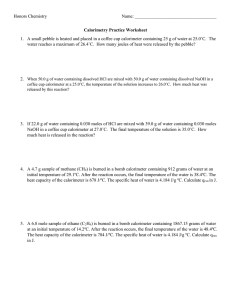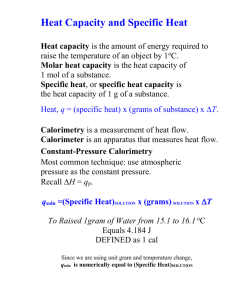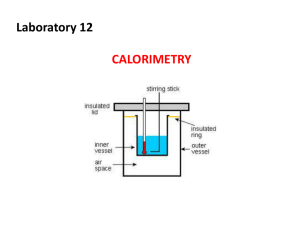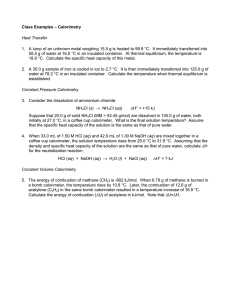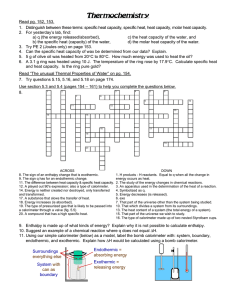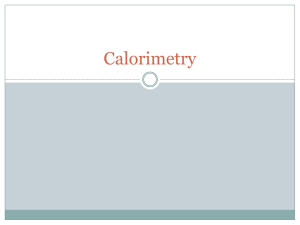Hints on solving calorimetry probs 2
advertisement
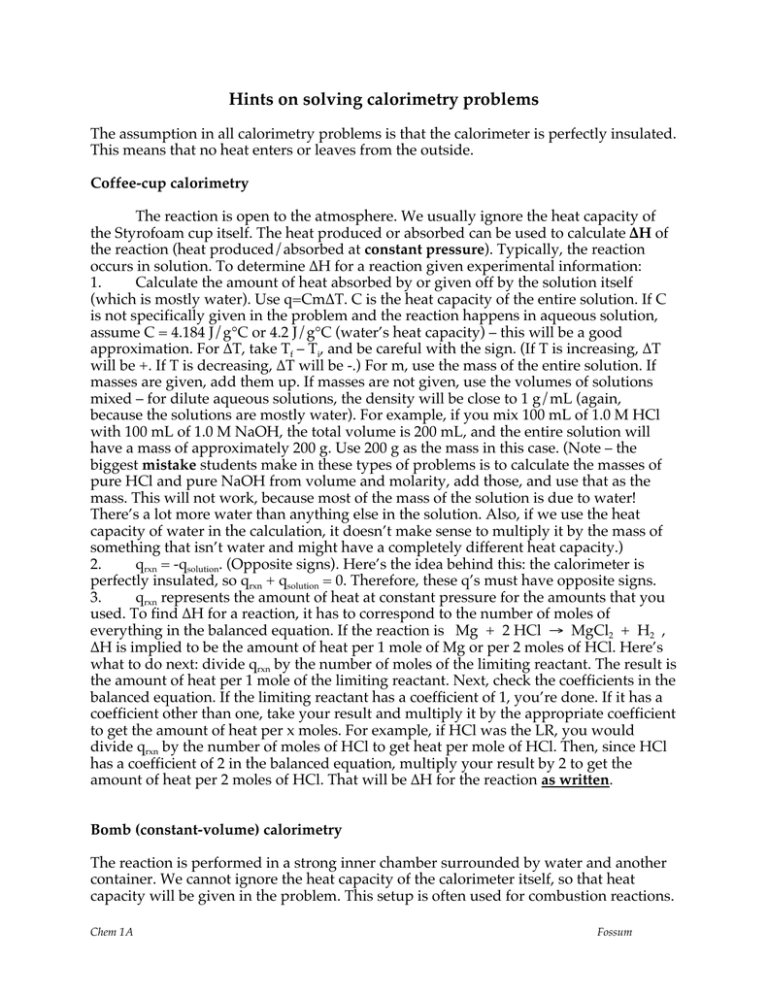
Hints on solving calorimetry problems The assumption in all calorimetry problems is that the calorimeter is perfectly insulated. This means that no heat enters or leaves from the outside. Coffee-cup calorimetry The reaction is open to the atmosphere. We usually ignore the heat capacity of the Styrofoam cup itself. The heat produced or absorbed can be used to calculate ∆H of the reaction (heat produced/absorbed at constant pressure). Typically, the reaction occurs in solution. To determine ∆H for a reaction given experimental information: 1. Calculate the amount of heat absorbed by or given off by the solution itself (which is mostly water). Use q=Cm∆T. C is the heat capacity of the entire solution. If C is not specifically given in the problem and the reaction happens in aqueous solution, assume C = 4.184 J/g°C or 4.2 J/g°C (water’s heat capacity) – this will be a good approximation. For ∆T, take Tf – Ti, and be careful with the sign. (If T is increasing, ∆T will be +. If T is decreasing, ∆T will be -.) For m, use the mass of the entire solution. If masses are given, add them up. If masses are not given, use the volumes of solutions mixed – for dilute aqueous solutions, the density will be close to 1 g/mL (again, because the solutions are mostly water). For example, if you mix 100 mL of 1.0 M HCl with 100 mL of 1.0 M NaOH, the total volume is 200 mL, and the entire solution will have a mass of approximately 200 g. Use 200 g as the mass in this case. (Note – the biggest mistake students make in these types of problems is to calculate the masses of pure HCl and pure NaOH from volume and molarity, add those, and use that as the mass. This will not work, because most of the mass of the solution is due to water! There’s a lot more water than anything else in the solution. Also, if we use the heat capacity of water in the calculation, it doesn’t make sense to multiply it by the mass of something that isn’t water and might have a completely different heat capacity.) 2. qrxn = -qsolution. (Opposite signs). Here’s the idea behind this: the calorimeter is perfectly insulated, so qrxn + qsolution = 0. Therefore, these q’s must have opposite signs. 3. qrxn represents the amount of heat at constant pressure for the amounts that you used. To find ∆H for a reaction, it has to correspond to the number of moles of everything in the balanced equation. If the reaction is Mg + 2 HCl → MgCl2 + H2 , ∆H is implied to be the amount of heat per 1 mole of Mg or per 2 moles of HCl. Here’s what to do next: divide qrxn by the number of moles of the limiting reactant. The result is the amount of heat per 1 mole of the limiting reactant. Next, check the coefficients in the balanced equation. If the limiting reactant has a coefficient of 1, you’re done. If it has a coefficient other than one, take your result and multiply it by the appropriate coefficient to get the amount of heat per x moles. For example, if HCl was the LR, you would divide qrxn by the number of moles of HCl to get heat per mole of HCl. Then, since HCl has a coefficient of 2 in the balanced equation, multiply your result by 2 to get the amount of heat per 2 moles of HCl. That will be ∆H for the reaction as written. Bomb (constant-volume) calorimetry The reaction is performed in a strong inner chamber surrounded by water and another container. We cannot ignore the heat capacity of the calorimeter itself, so that heat capacity will be given in the problem. This setup is often used for combustion reactions. Chem 1A Fossum Since volume cannot change, no work can be done in this situation. All of the energy involved in this situation is produced as heat. (The amount of heat you would get from this reaction if it were performed in an open container is often different.) The heat produced or absorbed can be used to calculate ∆E of the reaction (heat produced/absorbed at constant volume). To determine ∆E for a reaction given experimental information: 1. Calculate the amount of heat absorbed by or given off by the calorimeter. Often, the heat capacity of the entire calorimeter (including the water) will be given, and it is usually in units of kJ/°C (note there are no grams in the units). qcalorimeter = C∆T in this case. If there are no mass units in the given heat capacity, do not multiply the heat capacity by the number of grams! Sometimes the amount of water and the heat capacity of just the calorimeter are given separately. In that case, qcalorimeter = qwater + qcontainer/bomb. Calculate the qwater and the qbomb separately and add them together. (Use q = Cm∆T to calculate q for the water. Use the given heat capacity of the calorimeter and the ∆T to find q for the container/bomb. q = C∆T) 2. qrxn = - qcalorimeter 3. Divide qrxn by the number of moles of the limiting reactant. Multiply by the coefficient of the LR in the balanced equation to get ∆E for the reaction as written. For either of these types of calorimetry (coffee-cup or bomb), once you know ∆H or ∆E, you can easily calculate the other. First , calculate w for the reaction as written, assuming constant pressure conditions. (wP = -∆ngasRT). Use the final T as the T in this equation. For ∆ngas, focus only on the gases in the balanced equation. (final-initial.) R = 8.314 J/mol•K. Then, since ∆E = q + w and since ∆E is a state function, we can choose any convenient path. If we decide on a constant pressure path, wP is what we just calculated, and q = ∆H. So ∆E = wP + ∆H, and ∆H = ∆E – wP. (All of these values must be for the reaction as written.) Calorimetry involving changes of phase Assume a perfectly insulated container. This is usually a constant-pressure (coffee-cup) calorimeter. Then determine how many separate processes are happening, and whether each process is exothermic or endothermic. Take the time to think this through, since a mistake here will completely throw off your results. The central relationship in this situation is: (total q for all endothermic processes) = - (total q for all exothermic processes) You may have more than one endothermic or exothermic process. There are lots of variations of this type of problem – you may be asked to calculate the mass of something or the heat of fusion or heat of vaporization or the final temperature. Set up an expression for the calculation of each process (change in temp or a phase change), and decide whether each process will be exo- or endothermic. Plug the expressions into: (total q for all endothermic processes) = - (total q for all exothermic processes) and solve for the missing variable. Chem 1A Fossum

